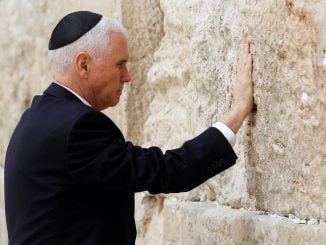
WASHINGTON, D.C. — President Donald Trump unveiled his long-awaited Middle East plan Tuesday, winning immediate praise from a beaming Israeli Prime Minister Benjamin Netanyahu but a swift rejection from the Palestinians, who called it “nonsense.”
Trump’s plan calls for the eventual creation of a Palestinian state but would leave sizable chunks of the occupied West Bank in Israeli hands.
Netanyahu said he would move forward on Sunday and ask his Cabinet to approve plans to annex West Bank territory — an explosive move that is likely to be met with harsh international reaction.
Trump called his plan a “win-win” for both Israel and the Palestinians, and Netanyahu called it a “great plan for Israel.”
At a speech in the West Bank, Palestinian President Mahmoud Abbas dismissed the plan as “nonsense.”
“We say 1,000 no’s to the Deal of the Century,” Abbas said, using a nickname for Trump’s proposal.
“We will not kneel and we will not surrender,” he said, adding that the Palestinians would resist the plan through “peaceful, popular means.”
With Netanyahu standing beside him, Trump presented the plan at a White House ceremony filled with other Israeli officials and allies, including evangelical Christian leaders and wealthy Republican donors but no Palestinian representatives.
The Palestinians seek all of the West Bank and east Jerusalem — areas captured by Israel in the 1967 Mideast war — for an independent state and the removal of more than 700,000 Israeli settlers from these areas.
Under the terms of the “peace vision” that Trump’s son-in-law and senior adviser Jared Kushner has been working on for nearly three years, all settlers would remain in place, and Israel would retain sovereignty over all of its settlements as well as the strategic Jordan Valley.
Trump acknowledged that he has done a lot for Israel, but he said he wanted the deal to be a “great deal for the Palestinians.”
He said his vision gives the Palestinians the time needed for them to meet the challenges of statehood.
The plan requires a four-year freeze on the establishment of new Israeli settlements in certain areas of the West Bank. But Netanyahu clarified later that this only applied to areas where there are no settlements and Israel has no immediate plans to annex, and that he considered the plan to impose no limitations on construction.
Thousands of Palestinians protested in Gaza City ahead of the announcement, burning pictures of Trump and Netanyahu and raising a banner reading “Palestine is not for sale.”
Trump said he sent a letter to Abbas to tell him that the territory that the plan has set aside for a new Palestinian state will remain open and undeveloped for four years.
“It’s going to work,” Trump said. “If they do this, it will work. Your response to this historic opportunity will show the world to what extent you are ready to lead the Palestinian people to statehood.”
“President Abbas, I want you to know, that if you chose the path to peace, America and many other countries … we will be there to help you in so many different ways. And we will be there every step of the way,” Trump said.
The 50-page plan builds on a 30-page economic plan for the West Bank and Gaza that was unveiled last June and which the Palestinians have also rejected.
The plan envisions a future Palestinian state consisting of the West Bank and Gaza, connected by a combination of roads and tunnels. It also would give small areas of southern Israel to the Palestinians as compensation for lost West Bank land.
Netanyahu and his main political challenger in March elections, Benny Gantz, had signed off on the plan.
“Mr. President, because of this historic recognition and because I believe your peace plan strikes the right balance where other plans have failed,” Netanyahu said. “I’ve agreed to negotiate peace with the Palestinians on the basis of your peace plan. It’s a great plan for Israel. It’s a great plan for peace.”
Tuesday’s developments set the contours for his election campaign.
Netanyahu will highlight his close relationship with Trump and the “historic opportunity” provided by the peace plan, while Gantz will focus on Netanyahu’s legal woes. Netanyahu will soon go on trial for a series of corruption charges.
U.S. officials, speaking on condition of anonymity ahead of the plan’s release, said they expected negative responses from the Palestinians, as well as Turkey and Iran, but were hopeful that Jordan and Egypt, the only two Arab nations to have peace treaties with Israel, would not reject it outright.
Jordan gave the plan a cool reaction, saying it remained committed to a two-state solution based on Israel’s pre-1967 lines. It also said it rejected any unilateral move by Israel, referring to the annexation plan.
Egypt, the first Arab country to reach a peace deal with Israel, urged Israelis and Palestinians to carefully study the plan. The European Union also said it needed to study it more closely.
Officials said they expected Gulf Arab states like Saudi Arabia, the United Arab Emirates and others to cautiously welcome the plan.
Arab League chief, Ahmed Abuel-Gheit said the Palestinian reaction would define the Arab response. He spoke after meeting with Palestinian official Jibril Rajoub at the Arab League headquarters in Cairo.
The reaction of Jordan, which would retain its responsibilities over Jerusalem’s al-Aqsa Mosque under the plan, is particularly significant, according to the officials, who said Kushner and others were reaching out to Arab leaders ahead of the rollout.



